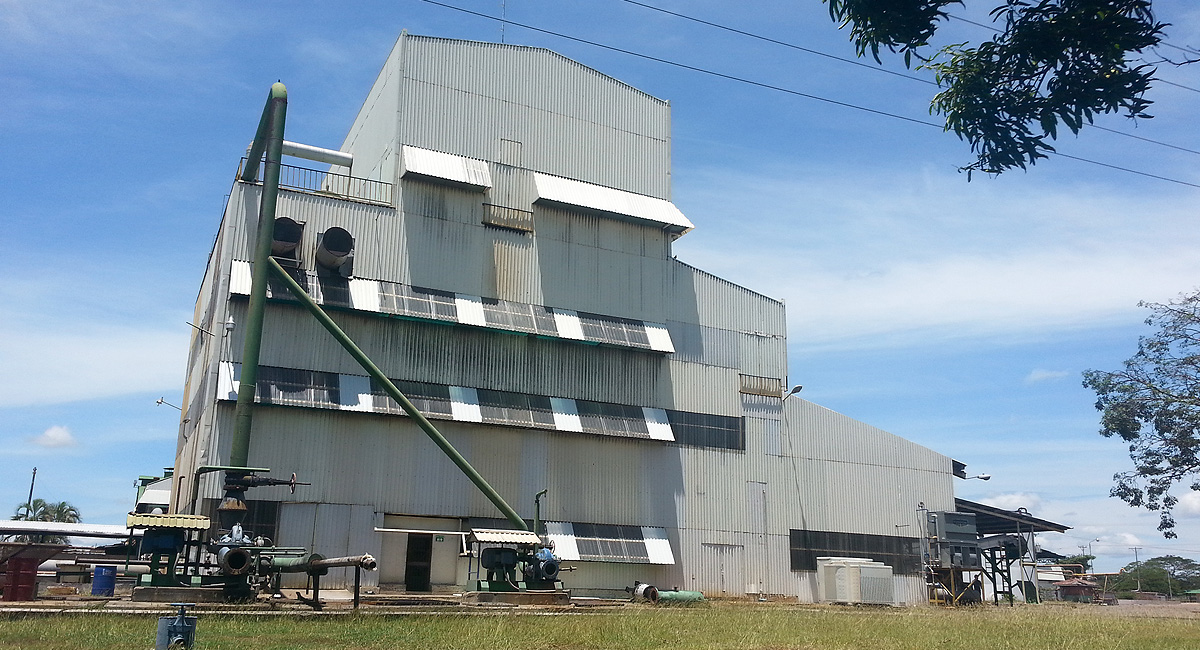Production
3,600 packages per day
Annual Production
12,500 metric tons of refined sugar
Products
Refined Sugar 45 UI, 70 UI y White Special 150UI.

REFINERY PROCESS
All the sugar from the Refinery is high quality. That’s why the elimination of the REFINED PROCESS in one of our system’s main characteristics. It would basically consists in the removal of the honey film from the sugar crystals of low quality input, using a set of specific unit operations for that purpose.
DISSOLUTION
The main objective of the dissolution process will be to obtain raw liquors dissolved at 65 ° Brix, without the presence of sugar crystals in suspension and at a controlled temperature not higher than 80 ° C.
Within the functional characteristics of this process, equipment is used that allows sugar to be pre-dissolved with sweet or condensed quelity water controlled through an endless element, which feeds the dissolution tank. The process requires two tanks equipped with helical type stirring mechanisms and heating with saturated steam.
These tanks are connected at the top through an overflow chute, on which there is an inclined stationary screen with a mesh that has an open area of 24% equivalent to a N ° 0.
Modern refining technology requires all coarse particles in suspension to be removed. The most common insoluble elements when the sugars do not meet the quality indicators, are the bagacillo and the particles of sugar cane sludge. In the first tank the dissolution takes place close to 65 ° Brix and in the second the final adjustment is processed. The total retention time is between 30 – 35 minutes under normal operating conditions.
The process of dosing sugar and dilution water is controlled automatically through a programmable electronic controller that guarantees compliance with the density and temperature variables.
DISCOLORATION
For this purpose and considering the quality of the raw liquor obtained in the dissolution of high quality white sugars; it is not necessary to carry out any clarification process for the removal of insoluble impurities and color reduction. Therefore, using adsorption technology with activated carbon powder in continuous contact; it is possible to decolor melted liquors up to 60%.
Among the main advantages offered by this scheme we can mention: the simplicity of its facilities, ease of operation and safety in the results for medium-sized refineries.
In summary, the process consists in treating the hot melted liquors (75 ° C) with an activated carbon solution, inside the continuous flow tanks, where the carbon-liquor ratio remains constant. These tanks have mechanical agitation to promote the suspension of the mixture and maintain an intimate contact. The residence time should not be longer than 35 minutes, enough time for immediate adsorption and no form of desorption.
In order for this system to work in a stoichiometric manner, it is necessary to use a fluid carbon preparation tank, where the coal is mixed with pure water in defined proportions and from where the dosing tank is supplied.
The cost of activated carbon will depend on four initial basic indicators:
1.The quality of the sugar that is consumed, due to its own characteristics of color, polarization, insoluble matter, etc.
2.The discoloration efficiency that is considered necessary for the final product that you want to produce.
3.The contact time and the liquor agitation system and the carbon type.
4.The pH of the medium and its temperature.
FILTRATION
In the second continuous contact tank, a filter aid solution is applied. This suspension is prepared with special diatomaceous silica and pure water in an anticipated tank of agitation; from which it is dosed to the melted liquor previously treated with activated charcoal.
The diatomite filtration process is a unitary operation composed of two stages. First, a thin protective filter aid layer (the pre-coat) is formed on the filter cloth by circulating and recirculating a mixture of filtered liquor with diatomite, between the pre-coat preparation tank and the filters.
Since most of the diatomite particles are smaller than the openings of the filter medium, the pre-layer will be formed by an agglomeration effect: by congestion of the particles against the pore walls of the filter medium.
Fundamentally the pre-layer has three basic functions:
1. Prevent the filtering surface (monofilament polypropylene fabric) from being obstructed by the impurities present in the treated liquor, thus prolonging the duration of the filtration cycle.
2. Facilitate the cleaning of the filtering surface at the end of the cycle
3. Produce the clarifying effect at the beginning of the cycle
After forming this pre-layer, small amounts of filter aid are dosed. As the filtration progresses, the filter aid and carbon, mixed with the bleached liquor, are retained in the pre-layer, continuously forming a new filtration surface. The tiny particles of diatomite provide innumerable microscopic channels that retain suspended impurities and allow the treated liquor to pass freely through the filter medium if it is obstructed.
In our case, we use a double filtration system. All the filters are circular self-filtering SUCHAR type. The filtering elements are composed of 36 vertical sheets each. Each plate has independent output, which allows to control the process individually.
In the first filtration, the treated liquor passes through the carbon layer and the pre-layer transverse, while the crystalline filtrate is conducted towards the exit stops at the ends of each sheet. Through this flow sector the filtered liquor is extracted towards the single head, being then discharged by a common “manifold” if the quality thereof is optimal in view of the operator. This liquor then receives a second filtering or polishing to guarantee the obtaining of liquors with more than 60 ° Brix and color between 120 – 140 ICUMSA, free of suspension and with appreciable brightness.
In general, the filters operate continuously until the production volume is approximately 30% of the maximum flow and / or the operating pressure is about 4.6 Kg / cm2 (60 PSIG). When this condition occurs there will be a need to alternate them with another one just pre-caped. Once the change is made, it is liquidated. The washing is then carried out with pure hot water until it is exhausted in such a way that the effluent filtrate has 0 ° Brix. Once this stage is reached, the saturated cake (diatomite, coal and impurities) is discharged through the lower part with the help of the pressurized hot water sprinkler system.
CRYSTALLIZATION
The crystallization of pure solutions (filtered liquors) comprises two well differentiated processes: the appearance of crystalline seeds in the heart of the solution and the growth of these tiny elements. The modern technique includes the artificial addition of crystalline nuclei via seedling and the control of the growth of the inoculated crystals. In a pure system (refined sugar) as the gradient and the driving force is the concentration, the injected cores will cause an impact and will form an enormous additional amount of crystals.
The government of the system, will be given by three fundamental operations, liquor feeding, evaporation of the tank and the degree of mobility of the mass. The feeding – evaporation ratio will be given by the degree of constant concentration of the crystalline system. The adjustment of the concentration in three operating stages always increasing, determines that the speed of crystal growth is appreciably constant. If the degree of mobility of the bin is not sufficient, the local supersaturations will cause false grains and abnormal crystallizations. As the system is not ideal, many of the crystals are broken by colliding against each other, with the walls of the tank and, in addition, many microcrystals are formed.
The crystallization operation is carried out in such a way that the solution or liquor remains oversaturated with respect to the germs introduced, but not oversaturated with respect to the tiny grains formed under the working conditions.
In essence, the crystallization of pure solutions will have at least three adjustments of Brix degree, at the same pressure and without other internal agents that govern the system, only the concentration and mobility of the system.
In summary, we can define that the work of crystallization operation of the refiningJ process, is divided into three consecutive stages: seed, control of crystal growth and point or termination of cooking.
The system of production of refined sugar adopted by RATSA, is referred to the basic production of four masses. For this purpose, the filtered or final liquor is subjected to successive firings until the mentioned quantity of masses A, B, C and D is completed. Under this scheme, refining sugar of 99.8 ° of minimum polarization and 45 units can be packed by suitable mixture. ICUMSA color.
CENTRIFUGATION
Centrifugation, is the unitary operation of solid – liquid separation, where the main objective is to recover the solid (crystals) by giving physical-chemical characteristics, using the force of gravity and combining the washings with pure water at temperatures close to boiling .
The centrifugation or purging of the four cooked doughs mentioned above also produces four different types of refined sugar and their respective syrups, namely A, B, C and D.
The sugars A, B, C and D are immediately transported through conveyors of the auger type and elevators to the drying and packaging process. On the other hand, the respective syrups are pumped up to the different storage tanks located in the floor of buckets, to be reprocessed and exhausted in the different cooking.
DRYING AND PACKAGING
Our drying system consists of two rotating cylindrical drums installed in inverted inclined planes, placed one on top of the other. The first dries and the second cools the sugar. In general, dryer technology is countercurrent in terms of air flow and sugar. The temperature of the sugar after drying is of 60 ° C and after cooling is 40 ° C.
In the sugar refining industry, drying is an operation that you must do, since it is the final finishing of the product in terms of quality, presence and guarantee during the storage period.
The cold sugars pass through conveyor systems and worm screw, to their respective storage hoppers; from where they are extracted by adjustable vibration mechanisms making the respective mixtures for packaging.
At present, only an automatic weighing system is available for the presentation of polypropylene bags with a 50 kg pilietileno liner.




